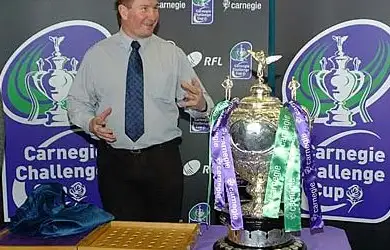Time to stop seeding Championship clubs in the third round

The third round of the Challenge Cup was drawn on Tuesday. The ties are:
Oulton Raiders v Sheffield Eagles
North Wales Crusaders v Toulouse Olympique XIII
London Skolars v Leigh Centurions
Myton Warriors v Halifax
York City Knights v Hull Dockers
Gateshead Thunder v York Acorn
Hunslet Old Boys v Featherstone Rovers
Swinton Lions v Siddal
Workington Town v Batley Bulldogs
Doncaster v Sharlston Rovers
Egremont Rangers v Oldham
Whitehaven v Hunslet Warriors
Wath Brow Hornets v South Wales Scorpions
Barrow Raiders v FC XIII Lezignan
East Hull v Rochdale Hornets
Hunslet Hawks v Royal Navy
Bradford Dudley Hill v Keighley Cougars
Dewsbury Rams v Thatto Heath Crusaders
There are only two all-Championship ties, with London Skolars hosting Leigh Centurions while Batley travel to Derwent Park to face Workington Town.
The remaining ties see Championship clubs face community clubs or French opposition, which is certainly no coincidence.
The third round is significant for community clubs as it guarantees them a tie against professional opposition. The draw is fixed to provide this outcome, but in my opinion this makes the third round less significant and 99 per cent predictable.
There is little excitement in the third round and this was demonstrated in last year’s competition. None of the 14 tier three clubs (amateur, armed forces or university teams) made it past their professional opponents in tier two of the RFL’s playing structure.
Northumbria University were subject to a record 132-0 defeat to York City Knights in last year’s competition, while there were heavy score lines in favour of Featherstone (defeated The Army 86-0), Widnes (beat Siddal 54-6), Batley (thrashed Fryston Warriors 64-10), Sheffield (defeated Leets Met 82-0) and Halifax (hammering Castleford Lock Lane 76-6.)
Other than the obvious financial implications, what incentive is there for community clubs to progress past the third round? Realistically there is remote possibility that a tier three side will perform a giant killing from the higher tier, which makes the third round almost a foregone conclusion.
For a sport that is petrified of one-sided games, why do we insist on allowing community clubs to be fed to the slaughter in such a one-sided draw format?
Heavy score lines are inevitable in competitions where there is a huge gap in the skill level between top flight domestic teams and lower league sides.
It is almost expected that a team from a higher division will overcome a lower league club. But he romance of the Challenge Cup, and knockout competitions in general, has always been the slim possibility of that the underdog team can perform a giant killing.
Arguably one of the most famous giant killings in recent Challenge Cup memory was when Widnes travelled to Toulouse, and lost 40-24 in 2005.
Toulouse had been placed in with the remaining community clubs certain to face professional opposition. Justin Morgan’s side overcame Blackpool, Wath Brow Hornets, and Doncaster before hosting the Vikings.
The chance for Toulouse to face Super League opposition, never mind beat them, was an incredible achievement for the French club but they had to overcome the high odds stacked against them.
It was a fairytale cup run.
Toulouse proved it was possible to overcome the odds and reach the semi finals, and as a result they were given a substantial financial reward.
Community clubs may be content with achieving a third round tie and taking the money, but in a free draw they could earn more reaching the fourth round having defeated a fellow community club.
There is no need to pretend that any tier three sides will reach the final at Wembley, but by making the third round draw a free draw from seeding it allows small teams to dream of playing against their Super League heroes.
And that experience is something money could never buy!